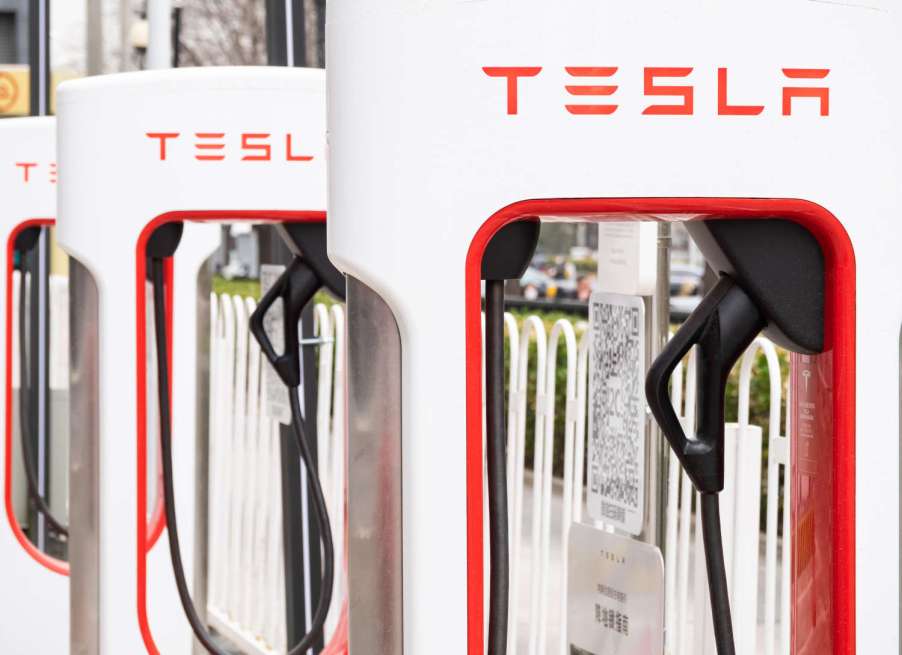
How Do You Charge a Non-Tesla EV at a Tesla Supercharger?
Tesla has opened its Supercharger network for non-Tesla EVs, which means easier charging for everyone. Find out how you can charge a non-Tesla EV at a Tesla Supercharger and what some drivers have paid for charging so far. The EV maker is working on building out the network more in the next two years, so not every station is equipped to charge a Rivian, Ford, or Mercedes-Benz electric vehicle yet. You’ll need a Magic Dock-enabled Tesla Supercharger for that.
Can you use a Tesla supercharger on a non-Tesla EV?
Tesla opened its Supercharger Network to non-Tesla electric cars earlier this year in the U.S. It plans to have 7,500 chargers open to non-Tesla vehicles and Tesla EVs by the end of 2024 to qualify for some of the millions set aside for the Bipartisan Infrastructure Law. Currently, non-Tesla EVs need to download the Tesla app (version 4.18.0 or higher) to get started. Add a payment method and look for a charger nearby. The Tesla Supercharger map online also can find Superchargers open to Non-Tesla EVs.
Drivers must use the app to find a charger equipped with the Tesla Magic Dock. This allows Combined Charging System (CCS) equipped electric cars to charge, which is most non-Tesla vehicles. Once the app recognizes the payment, drivers will be able to grab the charging cable and plug it in like any other charger. Magic Dock-equipped chargers will have the CCS adaptor needed for charging.
After that, the charging experience should go on as expected. Some drivers have experienced slower charging speeds than one might expect with a Tesla. This will likely improve with the new chargers and as Tesla continues to update its Supercharger Network.
How much does it charge a non-Tesla EV at a Tesla Supercharger?
Consumer Reports was one of the first to travel to the Magic Dock equipped Tesla Superchargers and shared the cost. Ranging from $0.48/kWh to $0.55, $0.49/kWh seemed to be the most common. This is similar in price to charging at an Electrify America charger without a subscription.
The Lucid Air charged at $0.49/kWh and saw peak charging speeds of 49kW. This could be because the 900-volt charging system doesn’t always work with older 400-volt charging networks. Charging with the Mercedes-Benz EQE and Kia EV6 also ran at $0.49/kWh. The EV6 saw charging rates of 40kW, but the EQE saw faster speeds of 76kW.
Tesla’s Superchargers are capable of charging Tesla vehicles at 250kW, but it is expected other brands might not charge at the same speeds. For now, it might take a little longer and cost a little more to charge a non-Tesla EV at a Tesla Supercharger.
Do non-Tesla vehicles need an adapter?

The Magic Dock makes it so non-Tesla vehicles do not need an adaptor, as it acts as the adaptor. This will make charging much more convenient for other brands down the line, but the Tesla Supercharger network has a long way to go. Right now, there are two Magic Dock chargers in California and fewer than 10 in New York. Tesla is building the network right now, but these chargers won’t be close enough for many drivers.
Charging a non-Tesla EV at a Tesla Supercharger might be convoluted for the first few months, but it will improve over time. If you live in New York or California near the Magic Dock chargers, there should be instructions on the charger if you have more questions. Don’t forget you can charge up at Cracker Barrel, Buc-ee’s, and even 7-Elevent stations throughout the country if your local Supercharger isn’t Magic Dock equipped yet.



